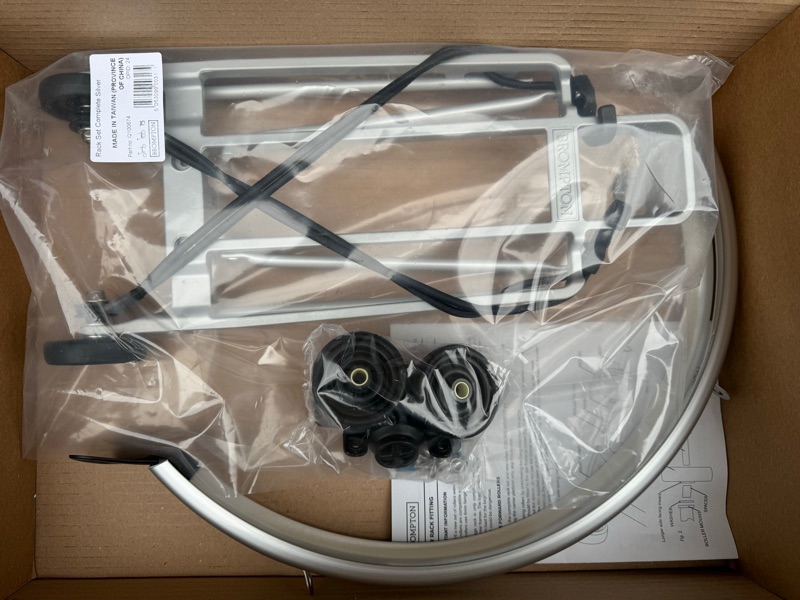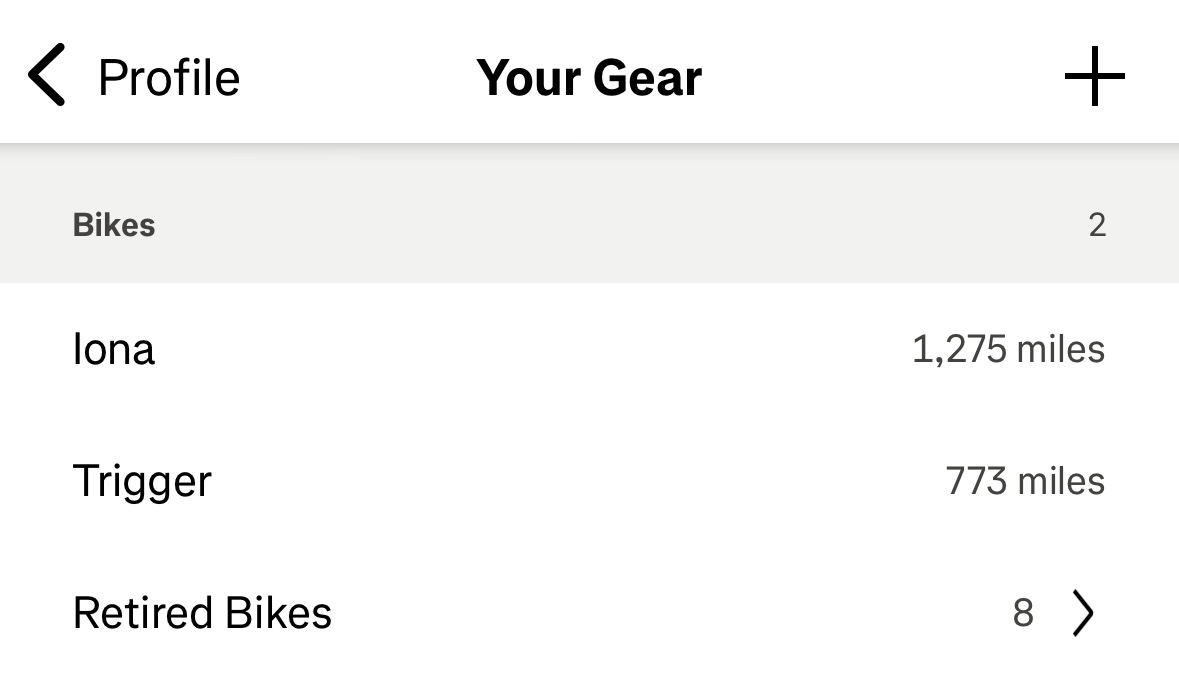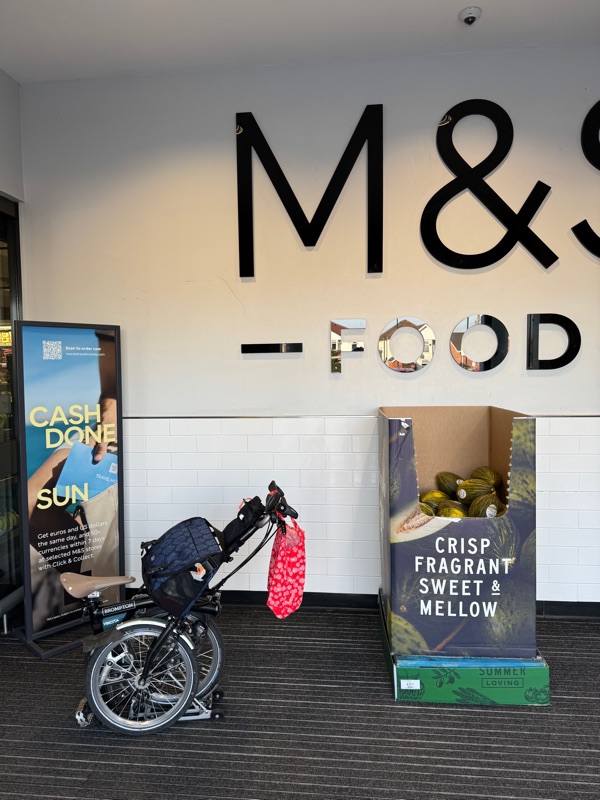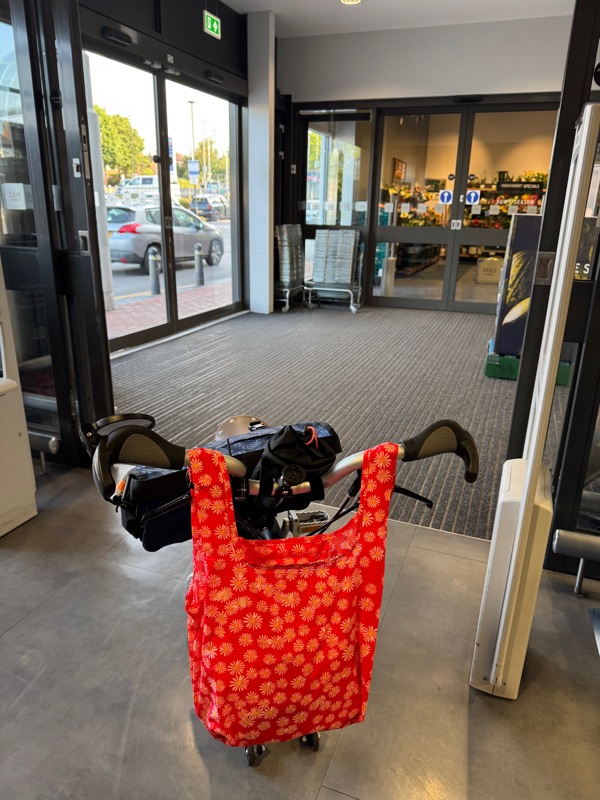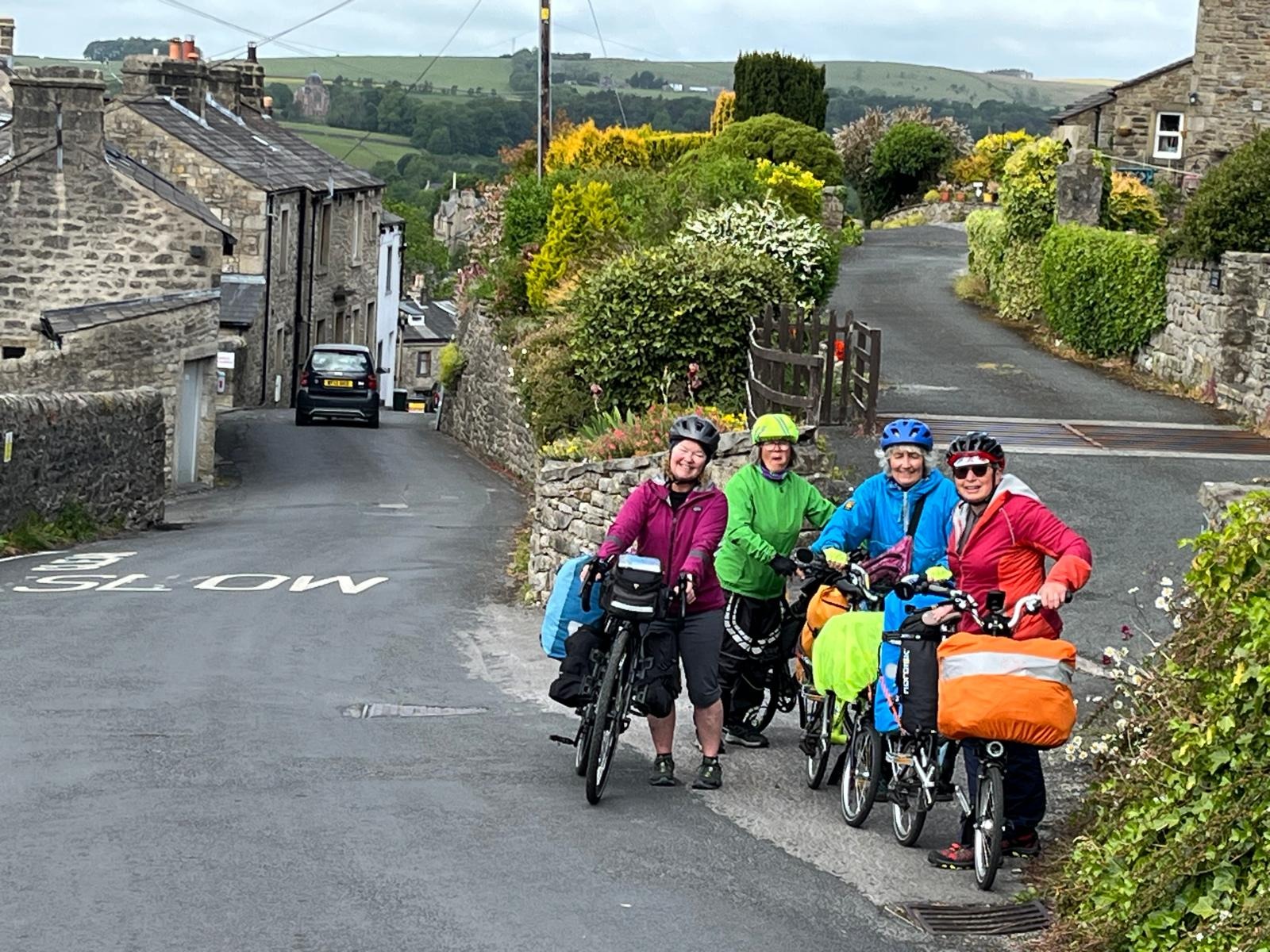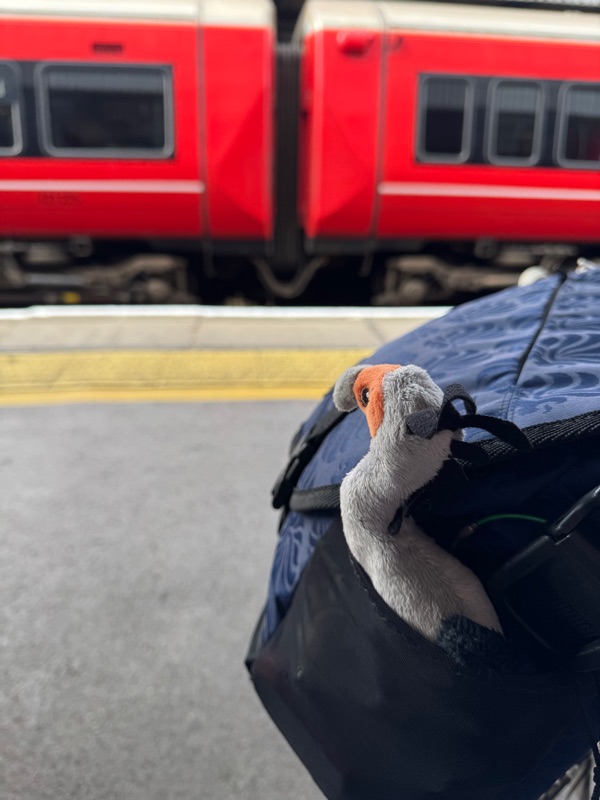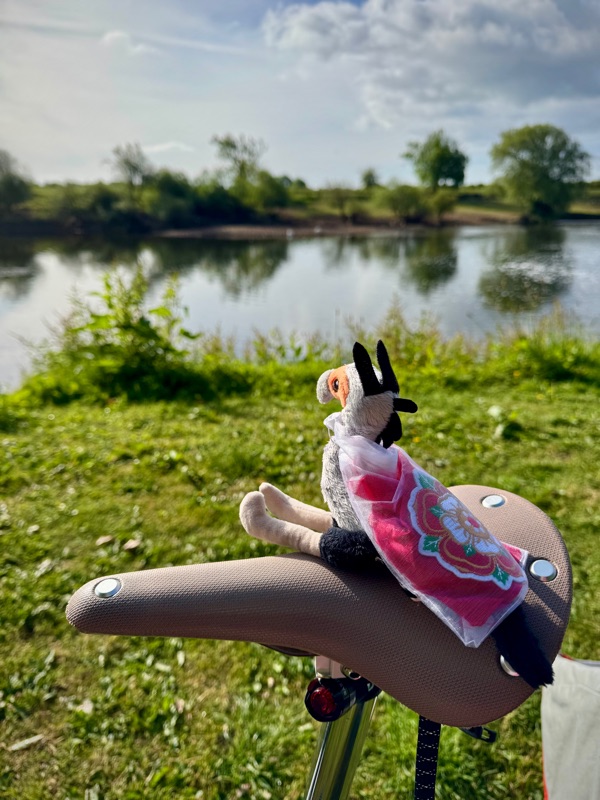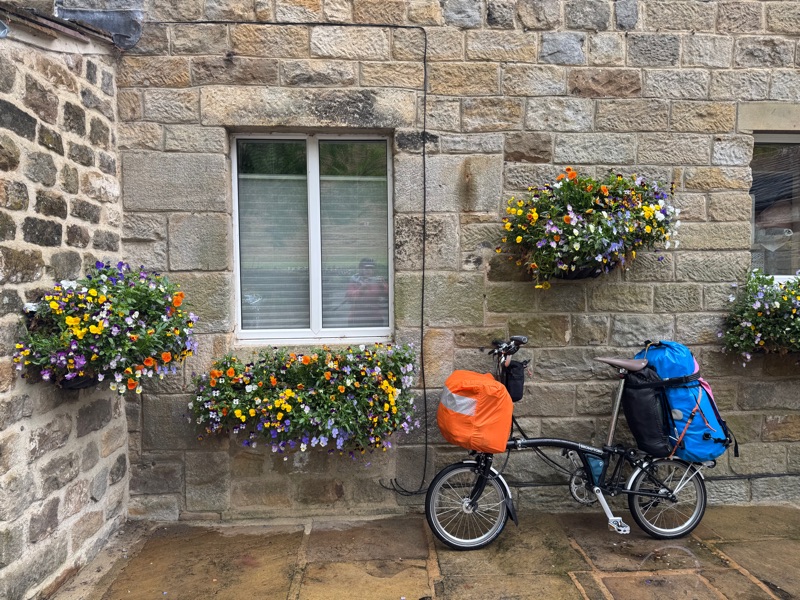It's looking like it's going to be a nice day, and being mid-summer, there are more than the average number of hours left of daylight. Even the trains are running normally. Sounds like the perfect recipe for a milepost adventure.
As is often the way, we rendezvoused in the cycle carriage of a train passing through Winchester on its way to London.
We had already spotted a kite while retracing our wheel tracks; we now found ourselves beside an airfield that we hadn't noticed when passing by the first time. It was a tiny one, and very busy with planes, but no passengers could be seen anywhere.
We crossed the Kennet via a bridge with large steps; fortunately, it had a bike ramp section built in, so we managed with ease, then found milepost number two.
Though the track was unpaved, the dry weather had baked the ground to near concrete, so our only hazards were tree roots and the river's edge.
As the path opened up to another stretch of green, we spotted a surprise post, one that I had missed during my initial route planning. This was very exciting (in a sad muppet kind of way), not only because we weren't expecting it, but also because of its shape.
There are four designs of mileposts, and this type - the McColl - is pretty rare and I think, my favourite.
The designs are named after their designers. So far on this ride, we have seen ‘The fossil tree’ by English designer John Mills, and the second post was ‘The Rowe type’ by Welsh designer Andrew Rowe. Both of these designs were used extensively around the country.
But this one, a McColl, was designed by Iain McColl, who represented Scotland and is named ‘The Cockerel’.
The final design is called ‘Tracks’ and was designed by the Northern Irish designer, David Dudgeon. This is so rare that I haven't actually bagged one yet.
The posts are each commonly referred to with the designer's surname rather than their given names.
They have all been painted in the last couple of years, and the map linked below gives credit to the artists/community groups that were involved with the repaint.
Jo and Jenny displayed two different versions of the following letter before we moved on.
Another river crossing, and this one was easy, as it was obviously designed for all active wheeled users.
Across the other side of the bridge was a convenient coffee van. Even though we had only ridden a couple of miles, it was now late morning, and we had travelled a long way to get here. We all agreed that we deserved a coffee break.
We sat for a while watching others enjoying this well-placed and well-used space, then dragged ourselves away to continue with our quest.
We turned into Caversham, losing the little red squares momentarily. ‘Are we still on the 5?’ asked Jo.
We were on the route that I’d plotted, and when looking back down the road, we could see the NCN5 squares pointing in the reverse direction down the road we had just ridden. But alas, looking back at the data now, it is clear to see the one route error (the purple line is the route), which led us to miss a post (the diamond symbol) that we would have gone back for if we'd known.
We were soon on more rural roads, with bigger houses in smaller clumps. As is often the way, a letterbox caught my eye, but poor photography doesn't show why.
We couldn't find the tree or see a common in Gallowstree Common, but we did come across a sign to the Maharajas' Well as we rode through Stoke Row. Intreagued, we followed the sign and were not at all expecting what was in front of us.
We read the information board to learn more about this structure and why it was here, practically in the middle of nowhere.
The well was funded by the Maharaja of Beneras, after numerous conversations with an English squire of this parish who had befriended him and told him of the squalid living conditions of the area where they passed cooking water from one household to the next, as there was no supply of water there. The canopy mimicked one that they often spoke under in the Maharaja's garden.
The well was dug by a single labourer using a bucket and reached a depth of twice Nelson's column or deeper than St Paul's Cathedral is high. At this depth, it met the underground reservoir, and its supply of water was tapped.
All that reading about water (and an increasingly hot sun) had made us thirsty, so when we saw a sign for a farm shop, we turned in. When we realised there was a cafe attached, we parked up and ordered some lunch too.
I was expecting a compost toilet as I headed to the shack that I had been directed to, but it was like any cafe toilet inside. Though I did sit pondering the need for the sign while using the facilities. Why would anyone consider doing such a thing?
Our lunch had arrived by the time I returned. It was delicious.
On the way out, we stopped to enjoy the beautiful view. We could just see the massive chimneys of Didcot on the horizon and knew we were heading in that general direction.
We had been talking to a chap at the well who sounded like he knew our route. He said that the roads from Didcot to Oxford were bustling, but the streets leading up to Didcot were lovely. We set out to enjoy what we could.
And our next point of enjoyment came very soon and in the form of another flight display, this time courtesy of a farmer, his tractor (not flying), 5 kites and a billion seagulls (I might be slightly exaggerating here)
As the farmer drove round, the birds of all denominations swooped and swirled behind his newly laid furrows.
Then, to add to our enjoyment, a Chinook from the local RAF station flew overhead, practised a landing and take off, then looped back behind us again. We stood watching till the farmer had passed us once more, then dragged ourselves away for the next part of our journey.
I knew the following post was about 26 miles from the start, so we still had a little way to go before we needed to keep an eye out.
The houses were becoming more joined up, and the roads were getting busier; we must be entering a town, and a beautiful one at that. This was Walingford.
We walked over the bridge, not because of the traffic, but because we wanted to enjoy the view of the young Thames. We ignored the signs to the castle and the constant lure of the coffee shops, but couldn't ride past a statue sitting on a park bench.
We took turns chatting to Dame Agatha Christie about her book, but she was giving nothing away, so we still had no idea who did it!
The Dame had lived her final 40 years in the town, and a number of her classics were set in the area. Another visitor to the bench explained that some of the films and TV series were also filmed locally. She then suggested that we should double back to see the castle grounds, as they look lovely this time of the year.
The sign at the edge of the park threw me as I leaned Iona up against it. The wingspan of those graceful kites we were watching earlier is greater than the wheelspan of my bike!! Mind blown!!
After visiting the gardens, which were beautiful but not very bike-friendly, I realised I needed the loo. I could either make my way into the Waitrose and cheekily use their facilities, or take Jo up on her offer of 10p and a new experience! I took the latter option, but apart from the fear of the door opening up, there was nothing to write home about!
We headed out of town and were now on the lookout for that next post.
It was not in excellent repair and was instead covered by the overgrown undergrowth surrounding it, but that wasn't bothering us right now. No, it was a lengthy discussion on how to form the next letter, which was holding us up. Of course, it was easier with two, and a new game plan was formed.
We detoured to the left to pick up post number 5. The unmistakable sound of a steam train in the background reminded us that we were now in Didcot and sent Jenny pedalling up the hill to see what could be seen, but not before the following letter was formed.
She returned having seen a glimpse of a train, but not enough to warrant us following in her tyre tracks. We rejoined our route at a rail bridge. This one has a teeny tiny gutter-type ramp for cycles, but I've never worked out how you use it without the pedals or handlebars getting snarled. So we did one of the many things that make Bromptons so wonderful, picked them up and carried them.
We rode through a tranquil industrial estate, then at a roundabout, we found our next post.
Since that conversation at the well, we had been worrying about the roads from this point on, but that chap can't have known about the NCN and the lovely paths of route 5. We spent the next hour or so riding beautiful shared paths in the middle of nowhere, punctuated every few miles by a new milepost. It was almost idílic
Then we were right beside those chimneys we had been keeping an eye on since lunchtime. The prominent landmark cooling towers that I used to look out for when travelling on the A34 were no longer there, but it was strange to be so close to the site right now.
It was now 530, by which time I had assumed we’d be in Oxford, but we still had 8 miles to go. I was so glad I’d paid the extra £2 for the open return train ticket. And once again, I marvelled at the way Jo’s route planning always works, and to the perfect time. I was responsible for this one, and though the route was great, my timekeeping was awful. Good job, we weren’t in a hurry!
We paused for water in Abingdon while enjoying the strange gargoyles on the building in front of us.
I noticed the modern equivalent of the mileposts we’d been chasing all day. They don’t have the same appeal in my opinion.
The following post was on a well-used footpath, and someone offered to take our photos for us twice within minutes. We politely declined while taking far too long to work out the shape of the next letter - it isn’t as easy as they make it look!
The girls decided to repeat the first few letters, this time using their newly formed double-person alphabet.
They looked so much cooler than I did at the next one. I was melting. They cooly pulled off an Abba-esque stance.
Our final post was the one where we said goodbye to NCN 5 and followed the Thames into Oxford, past numerous college rowing clubs and several crews out practising.
Our final photo was taken at a bridge to nowhere - well, maybe a small but ornate jetty that probably has a significant history. But for this trip, it was just a beautiful bridge.
We rode on into Oxford, too tired to take in any more scenery. We located the station, which appeared to have a bigger bike park than car park, bought some snacks and played railway roulette for the umpteenth time this year -
Will the train be cancelled at the last minute?
Will we all be able to get on together?
Do we need to pre-fold the bikes?
I love using the train and my bike - it feels like it should be a match made in heaven, but I can fully understand why people have given up on this as a realistic transport option. If only they could sort it, and the world would take another step away from the awful car dependence we have right now.
Thank you, Jo and Jenny, for another incredible adventure, and your crazy letter-forming antics are still making me smile every time I look at the pics.
Thank you both for indulging me on my quest to find all of these monuments before they (or I) become too rusty or are removed to allow further ‘development’ of the areas they mark.
And thank you to Sustrans, who had the foresight to bid for Millennium money to upgrade the National cycle network and provide these proud pieces of artwork all along it.
Further information -
Reading to Oxford - 42.82miles
Links

